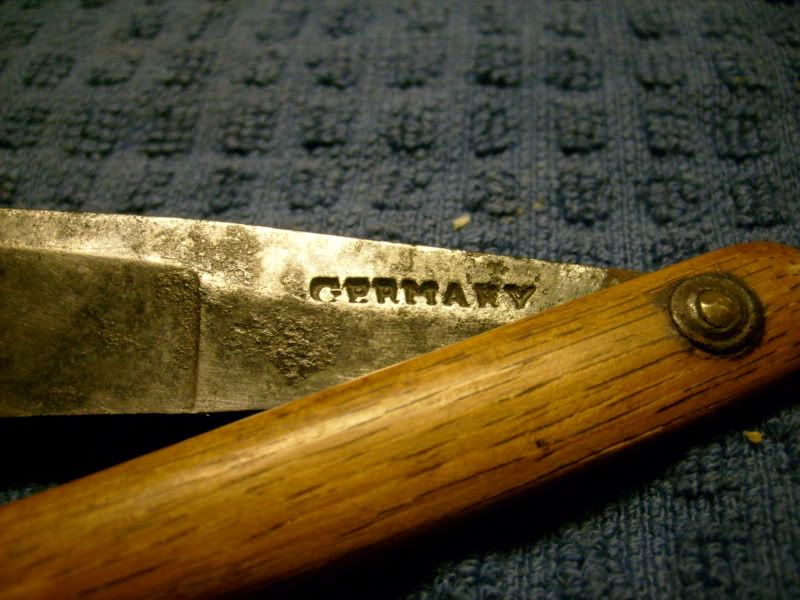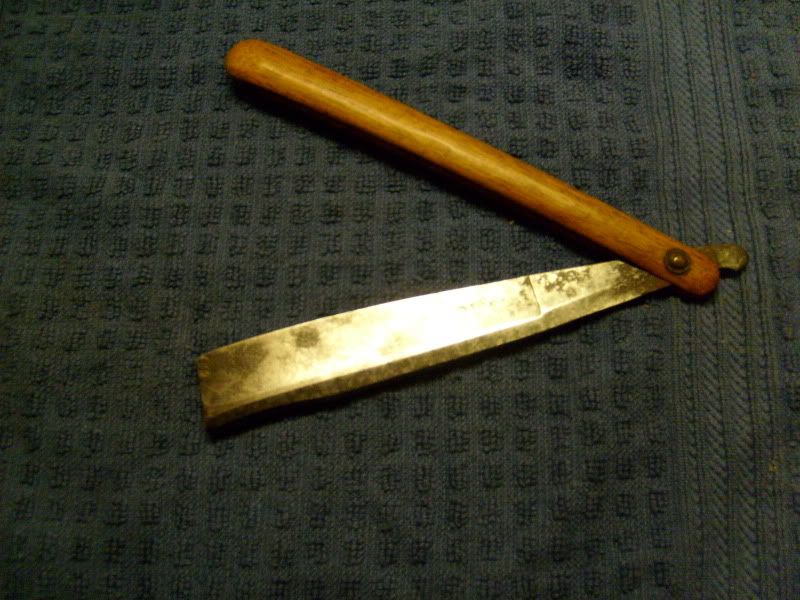Results 31 to 40 of 51
Thread: 1700's straight razor..
-
04-01-2011, 05:06 PM #31
-
04-01-2011, 05:38 PM #32
-
04-01-2011, 06:11 PM #33Junior Member

- Join Date
- Mar 2011
- Posts
- 13
Thanked: 1
I have been a locksmith for the last 17 years. Some of the recent business we have been picking up is bank foreclosers. We recently locked up a bank forecloser and cleaned it out for them. Once the property is repossed it's cleaned out and put back on the market. We found this laying in a pile of trash along with a few other things. The house had been empty for almost a year and was in horrible shape. We found books from the 1800's and furniture made in the 20's. This among other things would have been throwed away...
-
04-01-2011, 06:20 PM #34

Wish I lived close by!
I've done abandoned home clean outs before. Unfortunately all I ever found was rotten food, garbage, and weed. None of which holds any interest for me.
The circumstances of the find would lend support to (or at least not detract from) the authenticity of the razor: it wasn't in some flea market, or antique shop where someone was trying to make a buck off of it.
Peace,Last edited by BigJim; 04-01-2011 at 06:45 PM.
-
04-01-2011, 06:35 PM #35
-
04-01-2011, 07:02 PM #36Junior Member

- Join Date
- Mar 2011
- Posts
- 13
Thanked: 1
Yea you could tell this house was in the family for years. We found land contracts wrote up from the late 1800's, stamps, yada yada yada...you could tell as the generations lived in this house they just pushed all the older stuff into the corners and went on. Yea, we also found bongs and weed...that's prob why this house went back to the bank.
-
04-01-2011, 09:29 PM #37

The razor looks authentic , which is strange because of being stamped "cast steel" and "Germany" in English . I would have to think that it may have been made for export to the U.S. . I doubt it would have been exported to England because of their prolific domestic production of razors , and other cutlery in Sheffield . Of course , I could be all wrong . This razor may be very rare . I would leave the restoration to a person you does historical preservation type work . And I would strongly advise against using steel wool , sandpaper , or any other type of abrasive . I wouldn't try honing it either , since doing that would pretty much destroy any collector value the razor may have . But that's just me . It's your razor , so I can't tell you what to do with it . I'm just giving you my opinion .
Greetings , from Dundalk , Maryland . The place where normal people , fear to go .
-
04-01-2011, 11:17 PM #38Senior Member

- Join Date
- May 2009
- Location
- Staten Island,NY
- Posts
- 120
Thanked: 84
I will say that some razors before 1800 did have the cast steel marrking. Quite sure I have one. Huntsman sold his product solely to France, at first because of a lack of interest at home. It was marked 'acier fondu'. He sold to them for a period unknown to me, and fellow steel makers tried to block him from selling to France through the governmental process. He was not blocked, and eventually his process was found out, and other began using this harder steel. I'm guessing it was some time after discovery (1740's) before his production was an annoyance to others- and the ensuing block attempt. Lets say near 1760. In the 1770's demand went up for his steel. So much so, he considered moving his operation.
While some timing is guessed at, it's close enough. The oddest thing about this razor is that it is stamped in English for both 'cast steel' and 'Germany'. I mean, who were the intended buyers? England produced cutlery for the world, using German steel a lot.
So Solingen gets the process, or the steel, and then sells to the United States? Ahem, we didn't exist. Very odd! So was it sold back to England. Convoluted, at least. Maybe I'm missing the obvious.
All I know is that I want the razor.
Best of luck with that oddity.
Ed
quicknicker
-
04-02-2011, 12:28 AM #39Junior Member

- Join Date
- Mar 2011
- Posts
- 13
Thanked: 1
Thanks for all the replys guys! The history just keeps getting more and more interesting. I did some cleaning bye hand tonight with mineral oil and something called s100. It's used to clean the blueing off of chrome. It's a soap based paste that is very,very non-abrasive. I scrubbed for almost 2 hours. I got most of the rust and scale off but if I decide to go any further, I will seek professional help. Here are some pics...sorry there crappy. These were taken on a $40 camera compared to the others that was taken on a $800 camera...



Last edited by Framedragger79; 04-02-2011 at 12:36 AM.
-
04-02-2011, 01:06 AM #40Senior Member



- Join Date
- Apr 2008
- Location
- Essex, UK
- Posts
- 3,816
Thanked: 3164
Yes, it is certainly an interesting puzzle Ed. At one point english steel was sent to Germany, and the main constituent of that steel came from Swedish iron ore! In fact, Huntsman's process relied on high purity steel, and at that time it came from Swedish iron ore.
Perhaps the secret lies locked somewhere within the memoirs of James Watt, of steam engine fame. He had a lot of interaction with Matthew Boulton, who owned the Soho ironworks and who became Watts partner in Boulton & Watts Steam Engines. In my previous post I referred - erroneously! - as Matthew Boulton being an american steelmaster, but it was Robert Erskine I meant - he made a report of Matthew Boulton's process in 1770. Three years later and Erskine was reporting in more detail on the casting process. So there is at least one early american link. Boulton's establishment was based on Huntsmans method - maybe even licensed by Huntsman - and Boulton made every effort to persuade Huntsman to set up in Birmingham, the site of the Soho foundry, rather than Sheffield. Huntsman had his eye on Sheffield, though.
Not all of the Sheffield ironmasters turned their backs on Huntsman's process - there is a record of one Sheffield master using the process in 1760, so a direct link to 'cast steel' pre-dating the stamp of 'acier fondu' is not to be ruled out. Confusingly, there is also mention of William Jackson - again from Birmingham - going to France in 1815 to 'introduce the Huntsman process' which begs the question of whether before this the steel was produced in England and sold to France, rather than being made in France. It is a matter of record that Huntsman opened a steel plant in Sheffield in 1751.
Huntsman never patented the system, though, and it came into the hands of others in the 1750s - there are records of other Sheffield makers producing cast steel in the 1760s. There was a fellow called Samuel Walker who produced cast steel in the UK (there may be two Samuel Walkers: one the 'shivering beggar' who warmed himself by Huntsmans furnaces and stole his idea, and this Samuel Walker, company formed in 1741 - who used none other than a Boulton & Watt steam engine at his works!).
The 'German' connection (rather than the French Connection!) is very interesting...
Regards,
Neil
-


 17Likes
17Likes LinkBack URL
LinkBack URL About LinkBacks
About LinkBacks







 Reply With Quote
Reply With Quote


